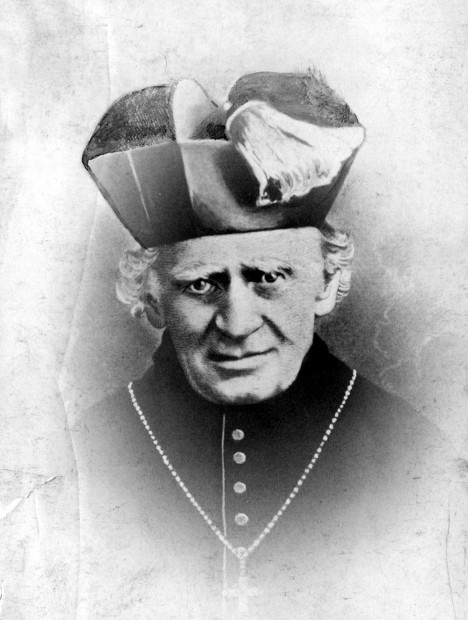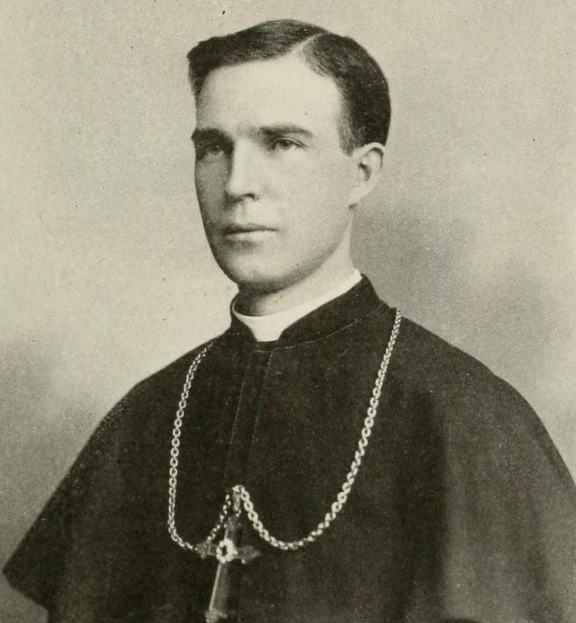1800s
Kenrick-Glennon Seminary traces its remote beginnings to the year 1818. In that year, members of the Roman Province of the Congregation of the Mission, the Vincentian Community, arrived in Perryville, Missouri.
In establishing Saint Mary’s of the Barrens Seminary in Perryville, the Vincentians established the first seminary west of the Mississippi River. They had come at the request of Bishop Louis William Valentine DuBourg, Bishop of the Diocese of Louisiana and the Floridas. This enormous diocese embraced all the sparsely-settled territory of the recent Louisiana Purchase as well as that of Florida and the eastern coast of the Gulf of Mexico.
The Diocese of Saint Louis was established in 1826 in the upper half of this territory, under one of the Vincentian pioneers, Bishop Joseph Rosati, C.M. The seminary students of the new diocese shared the Vincentian facilities at Perryville until 1842. Its minor seminary students remained until 1858.
In 1842, the diocesan Major Seminary acquired an identity of its own. Bishop Rosati’s coadjutor and successor, Bishop Peter Richard Kenrick (in 1847, Archbishop Kenrick), transferred his students to Saint Louis. He entrusted them to a Vincentian house, which was opened for this purpose in a group of temporary buildings later called Bishop’s Row, on Carroll Street, in the Soulard area of south Saint Louis.
A year and a half later, in response to deep privations at that site, he relocated the tiny Seminary one block away, in the Vincentian owned Soulard Mansion on Decatur Street. This building, which stood next to the new Saint Vincent Church, served as the third home of the Diocesan Seminary until 1848. In that year Archbishop Kenrick opened a seminary in Carondelet, a village south of Saint Louis, later annexed to the city. The Carondelet Seminary, located approximately two blocks northwest of the Motherhouse of the Sisters of Saint Joseph, was administered by four rectors of the Archdiocesan clergy until 1857. At that time, the Vincentian Community resumed its previous role of direction, now at the new site.
In the fall of 1858, the Second Provincial Council of Saint Louis made a new determination for the Seminary. By way of experiment, another Vincentian institute, Saint Vincent’s College, in Cape Girardeau, Missouri, was to serve as a regional seminary. The entire Archdiocesan Seminary thus transferred to Cape Girardeau, the Major Seminary moving from Carondelet, the Minor Seminary from Perryville. The dream of a regional seminary, however, was not to prosper, as the hostilities of the Civil War ensued.
Although no major battles of that war took place near Cape Girardeau, there were enough military maneuvers to cause concern. Enrollment dropped, and Archbishop Kenrick began to send students to other locations in addition to Cape Girardeau: Saint Francis Seminary, in Milwaukee; Saint Mary’s Seminary, in Baltimore; and the North American College, in Rome.
On September 21, 1893, Kenrick’s coadjutor and eventual successor, Archbishop John J. Kain, presided at the re-opening of the philosophy and theology departments of the Archdiocesan Seminary. The new Seminary, located in a former convent of the Visitation Nuns, at 19th Street and Cass Avenue in Saint Louis, was the first site to bear the name Kenrick Seminary. Once again, the Seminary was entrusted to the direction of the Vincentian Community.
1900s
In September 1900, Archbishop Kain also re-established the Minor Seminary, now Kenrick Preparatory Seminary, and located it at the Cass Avenue building.In 1915, as the Cass Avenue facilities proved inadequate, Archbishop Kain’s successor,
Archbishop John J. Glennon (in 1946, Cardinal Glennon), opened the second Kenrick Seminary. This Seminary was located on Kenrick Road, in an unincorporated area of Saint Louis County known at the time as Glennon Park. Today, it is in the City of Shrewsbury, adjacent to the southwest city limits of Saint Louis. Since 1987, this second Kenrick Seminary has been known as the Archdiocesan Pastoral Center, an office and retreat facility.
Archbishop Glennon formally dedicated the new Kenrick on April 27, 1916. The building housed both the philosophy and theology departments. As the second Kenrick opened, the Minor Seminary moved to a new location at 4244 Washington Avenue. In 1927, a tornado did extensive damage at this location. While plans were made for a new structure at a new site, the Minor Seminary found temporary housing at Saint Bridget’s Parish, at Jefferson Avenue and Stoddard Street.
In 1931, the first Saint Louis Preparatory Seminary, the present Kenrick-Glennon Seminary building, opened on the same spacious grounds as the second Kenrick. This facility housed the last two years of high school and four full years of college. The first two years of high school were reinstated at the refurbished Washington Avenue location, now known as the Cathedral Latin School. It was conducted by members of the Archdiocesan clergy.
In 1947, Cardinal Glennon’s successor, Archbishop Joseph E. Ritter (in 1961, Cardinal Ritter), closed the Latin School, and established six-year programs in the two Archdiocesan seminaries. Prep thus comprised four years of high school and two years of college, while Kenrick comprised two years of college and four years of theology.
In 1957, Archbishop Ritter opened a new facility for the high school, at 5200 Shrewsbury Avenue, on the same spacious grounds as Kenrick and the old Prep. Simultaneously, he effected a division of the Archdiocesan seminary system into three separate institutions. The new Prep was a four-year high school. The old Prep became a four-year college, within two years to be known as Cardinal Glennon College. Kenrick Seminary continued as a four-year theologate. Cardinal Glennon College received full accreditation from the North Central Association of Colleges and Secondary Schools in 1961.
The late 1950s and the early 1960s were boom years for vocational recruitment. By 1964, more than five hundred students crowded the small high school facility in Shrewsbury. In response, in 1965, Cardinal Ritter created yet another Archdiocesan high school seminary in north Saint Louis County. Saint Louis Preparatory Seminary North (its counterpart in Shrewsbury was subsequently called Prep South) was administered by members of the Archdiocesan clergy. It held its first classes in the basement of the old Sacred Heart School building, on North Jefferson Street in Florissant. A year later, it moved to its new facility on 3500 Saint Catherine Street, also in Florissant. Notably, Prep North, unlike its counterpart, Prep South, accepted non-clerical students, who formed a major part of its student body.
In 1966, as part of the reform of seminaries mandated by the Second Vatican Council, Cardinal Ritter authorized Kenrick Seminary to enter an experimental arrangement with the Saint Louis University Divinity School. Kenrick students, having first finished two years of study at the seminary, and still retaining residence there, were to take classes and earn degrees at the Divinity School. The arrangement, however, for a variety of reasons, proved unsatisfactory. In 1970, under Cardinal Ritter’s successor, John J. Cardinal Carberry, it was discontinued. In 1973, a reconstituted, free-standing Kenrick Seminary received full accreditation, both from the Association of Theological Schools in the United States and Canada, and from the North Central Association of Colleges and Secondary Schools.
The year 1980 saw the sale of two extensive, mostly-wooded portions of the three-seminary campus to the Cardinal Ritter Institute and to private developers. As a result, this former seminary property is today the site of a nursing facility and apartment complexes for the elderly, as well as the site of numerous private homes, apartments, condominiums, and a small shopping plaza.
In September 1986, Cardinal Carberry’s successor, Archbishop John L. May, after wide consultation, made the determination to consolidate the seminary system of the Archdiocese. In the spring of 1987, Kenrick Seminary moved from its location on Kenrick Road to the Cardinal Glennon College building on Glennon Drive, the present Kenrick-Glennon Seminary. In the process, Kenrick retained its status as a free-standing school of theology. The College, however, closed its free-standing undergraduate program and established a collaborative-model program, in conjunction with the Saint Louis University College of Philosophy and Letters. College seminary students in their first two years attend Saint Louis University for classes but reside at the Kenrick-Glennon Seminary complex, where they receive their human and spiritual formation. Third and fourth year college seminarians complete their philosophy studies at Cardinal Glennon College.
As part of the same consolidation of the Archdiocesan system, Saint Louis Preparatory Seminary North was closed in the spring of 1987. The two high school seminaries were amalgamated that fall at the facility in Shrewsbury, known once again simply as the Saint Louis Preparatory Seminary. Even this measure, however, could not stop the spiral of mounting costs and decreasing enrollment. In January 1991, Archbishop May reluctantly announced the closing of the high school seminary, to take place that May. After extensive renovation of the Kenrick-Glennon building, the New Start—as Archbishop May called the entire program of consolidation—was in place by September 1, 1987. A Board of Trustees for Kenrick-Glennon Seminary began formal operation on October 11, 1988. In the spring of 1995, Archbishop Justin Rigali (in 2003, Cardinal Rigali) announced that after 177 years of collaboration between the Vincentian Community and the Archdiocese in the running of the Seminary, the Archdiocese would henceforth assume full responsibility.
2000s
In 2009 the Faith for the Future Capital Campaign was conducted in the Archdiocese of St. Louis for the purpose of financing the renovation of the seminary building. The entire seminary community moved to a temporary residence for a year and a half during the renovation. The project was completed in January of 2013. The new infrastructure was installed while maintaining the original architectural integrity of the facility. This project won an award from the American Institute of Architects.








